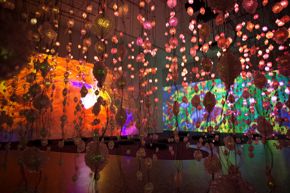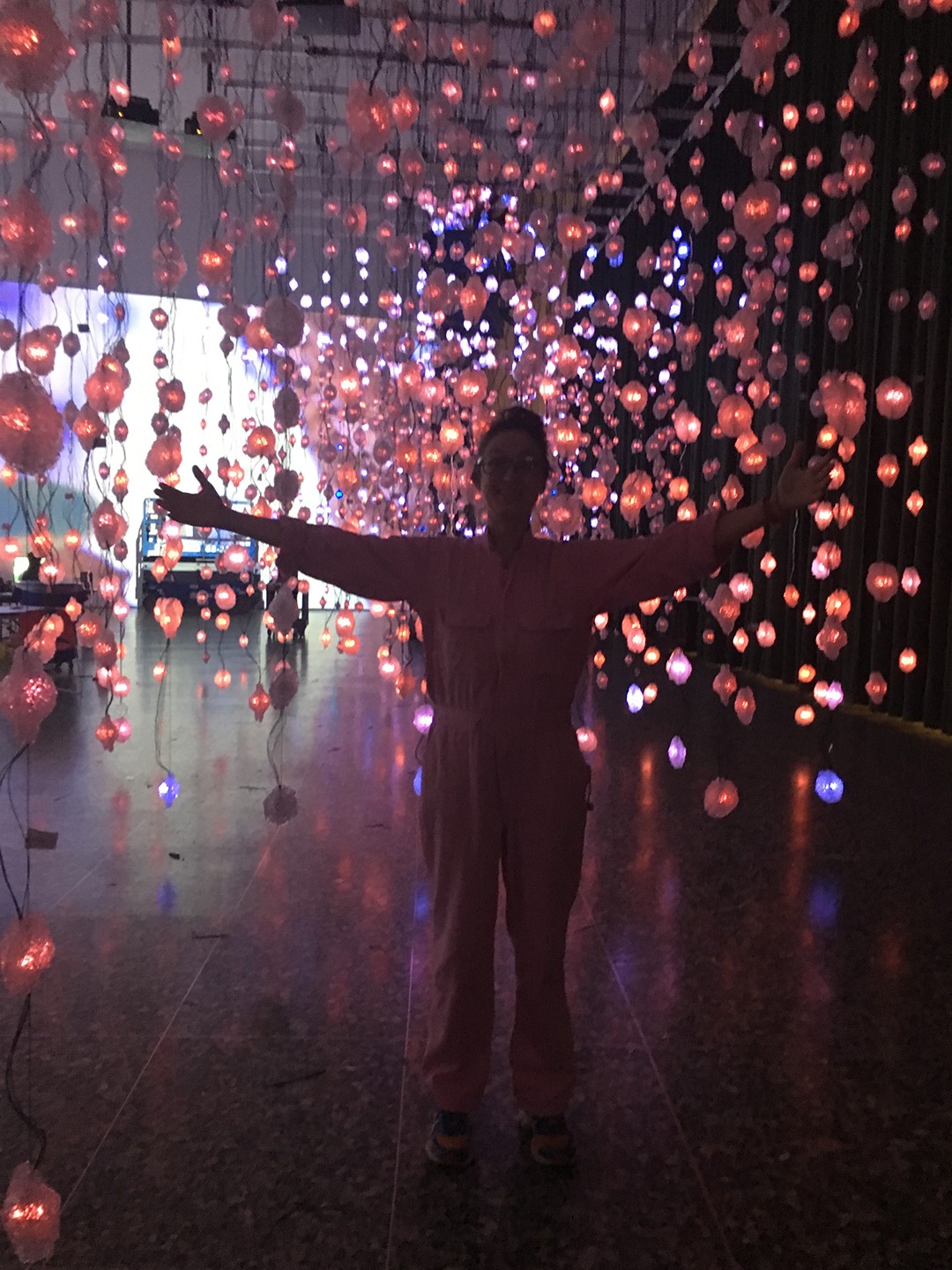Every Dot Knows Where It Is: A Chat with Pipilotti Rist June 26, 2017

Pipilotti Rist, Pixel Forest, 2016, LED installation with media player, the Museum of Fine Arts, Houston, Museum purchase funded by the Caroline Wiess Law Accessions Endowment Fund. © Pipilotti Rist / Photo: The Storyhive
Pipilotti Rist stands in the Museum’s Cullinan Hall during the installation of Pixel Forest and Worry Will Vanish.
Summertime visitors to the Museum’s Law Building are greeted with floating strains of music and a mysterious, enormous forest-green curtain across the grand entrance of Cullinan Hall. What’s beyond the curtain? A dreamlike journey through nature, the body, and the heavens.
Pipilotti Rist: Pixel Forest and Worry Will Vanish brings together two immersive installations: Pixel Forest, a labyrinth of 3,000 hanging lights; and Worry Will Vanish, a two-channel video projection spanning two walls that takes you on a trip inside the body and into the cosmos. Additionally, cushions on the floor invite you to relax and watch the video for as long as you wish. Pipilotti Rist, the artist who created these magical works, visited the MFAH before the exhibition opened and kindly shared one of those cushions with me for a chat.

Pipilotti Rist during the installation of Pixel Forest and Worry Will Vanish
You created these two installations separately. How do they speak to each other?
The video is two screens, and for me, Pixel Forest is a screen, too—an abstract, exploded screen. The two works always speak to each other like instruments in an orchestra: Sometimes Pixel Forest and Worry Will Vanish are in harmony with one another; sometimes the rhythms are deliberately broken.
I read your quote “I am interested in the combination of nature and technology; these are not two different things,” and I really liked that idea. How do nature and technology meld in this exhibition?
A machine is always only an extension of our body. For example, a camera is a bad, simple copy of our very complex eye system. Our brains are made up of low-voltage electrode signals—Pixel Forest looks like a simplified brain. In a way, all technology is a copy of nature.
What was the process for putting these installations together?
Compared to other artists, I work very collaboratively. The light engineering is by one woman, Kaori Kuwabara, and I had Judith Lava help blend the two projections, adjusting the video to the room, which is called pixel mapping. Early on, Dave Lang was in charge of the projections and the grid, as well as all the hardware and transportation. And in the studio, I only have one full-time person.
The CGI for Worry Will Vanish is by Elefant Studios, Zurich, and all the real footage is from my own camera. Some of it is behind my house in the morning, when the sun’s light is flat and dew is out.
For Pixel Forest, the resin cases and data programs of each light are different. E. Goldschmidt made the cases one by one with a template and a mold, but no two are exactly alike in shape or effect. Additionally, before the resin got cold, she would add granules of the same material to the interior of each case to refract and diffuse the light further.
When it comes to the installation, it is important that the way they hang from cables looks chaotic, but every dot knows exactly where it is.
What do you hope people walk away feeling after they experience the exhibition?
Relaxed. Maybe they will look at the world a little bit differently. Maybe very simple things, like when they see traffic lights. And maybe they’ll see that the sun is the biggest projector of all.
Discover “Pipilotti Rist: Pixel Forest and Worry Will Vanish” this summer! See it in the Law Building through September 17.





